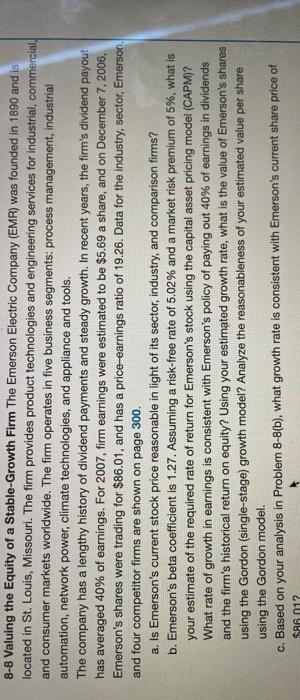PROBLEM 8-7 Given Cost of goods sold/Revenues Fixed operating costs Variable operating costs/Revenues Depreciation expense Salary adjustments Annual outsourcing savings/Revenues 55.00 259,000 10.00 50,000 a. Solution Scenario 1 1,000,000 Scenario 3 Scenario 2 000.000 Revenues Cost of goods sold Gross profits General and Administrative Expenses Net Operating Income "Includes depreciation expense of $50,000 per year. Percentage change b. Fixed operating costs Variable operating costs/Revenues $ 1 -2 23 24 25 26 27 28 29 30 50,000 30% Scenario 1 Scenario 2 Scenario 3 Revenues Cost of goods sold Gross profits General and Administrative Expenses Net Operating Income includes depreciation expense of $50,000 per year. 32 33 34 35 36 Percentage change 38 39 40 41 8-8 Valuing the Equity of a Stable-Growth Firm The Emerson Electric Company (EMR) was founded in 1890 and is located in St. Louis, Missouri. The firm provides product technologies and engineering services for industrial, commercial and consumer markets worldwide. The firm operates in five business segments: process management, industrial automation, network power, climate technologies, and appliance and tools. The company has a lengthy history of dividend payments and steady growth. In recent years, the firm's dividend payout has averaged 40% of earnings. For 2007, firm earnings were estimated to be $5.69 a share, and on December 7. 2006, Emerson's shares were trading for $86.01, and has a price-earnings ratio of 19.26. Data for the industry, sector, Emerson and four competitor firms are shown on page 300. a. Is Emerson's current stock price reasonable in light of its sector, industry, and comparison firms? b. Emerson's beta coefficient is 1.27. Assuming a risk-free rate of 5.02% and a market risk premium of 5%, what is your estimate of the required rate of return for Emerson's stock using the capital asset pricing model (CAPM)? What rate of growth in earnings is consistent with Emerson's policy of paying out 40% of earnings in dividends and the firm's historical return on equity? Using your estimated growth rate, what is the value of Emerson's shares using the Gordon (single-stage) growth model? Analyze the reasonableness of your estimated value per share using the Gordon model. c. Based on your analysis in Problem 8-8(b), what growth rate is consistent with Emerson's current share price of SAE 01? PROBLEM 8-7 Given Cost of goods sold/Revenues Fixed operating costs Variable operating costs/Revenues Depreciation expense Salary adjustments Annual outsourcing savings/Revenues 55.00 259,000 10.00 50,000 a. Solution Scenario 1 1,000,000 Scenario 3 Scenario 2 000.000 Revenues Cost of goods sold Gross profits General and Administrative Expenses Net Operating Income "Includes depreciation expense of $50,000 per year. Percentage change b. Fixed operating costs Variable operating costs/Revenues $ 1 -2 23 24 25 26 27 28 29 30 50,000 30% Scenario 1 Scenario 2 Scenario 3 Revenues Cost of goods sold Gross profits General and Administrative Expenses Net Operating Income includes depreciation expense of $50,000 per year. 32 33 34 35 36 Percentage change 38 39 40 41 8-8 Valuing the Equity of a Stable-Growth Firm The Emerson Electric Company (EMR) was founded in 1890 and is located in St. Louis, Missouri. The firm provides product technologies and engineering services for industrial, commercial and consumer markets worldwide. The firm operates in five business segments: process management, industrial automation, network power, climate technologies, and appliance and tools. The company has a lengthy history of dividend payments and steady growth. In recent years, the firm's dividend payout has averaged 40% of earnings. For 2007, firm earnings were estimated to be $5.69 a share, and on December 7. 2006, Emerson's shares were trading for $86.01, and has a price-earnings ratio of 19.26. Data for the industry, sector, Emerson and four competitor firms are shown on page 300. a. Is Emerson's current stock price reasonable in light of its sector, industry, and comparison firms? b. Emerson's beta coefficient is 1.27. Assuming a risk-free rate of 5.02% and a market risk premium of 5%, what is your estimate of the required rate of return for Emerson's stock using the capital asset pricing model (CAPM)? What rate of growth in earnings is consistent with Emerson's policy of paying out 40% of earnings in dividends and the firm's historical return on equity? Using your estimated growth rate, what is the value of Emerson's shares using the Gordon (single-stage) growth model? Analyze the reasonableness of your estimated value per share using the Gordon model. c. Based on your analysis in Problem 8-8(b), what growth rate is consistent with Emerson's current share price of SAE 01








